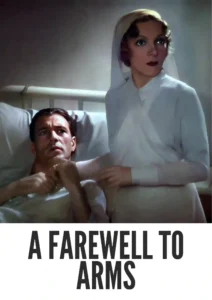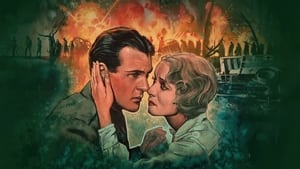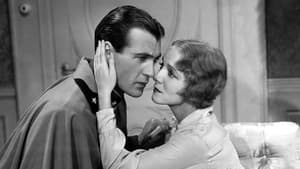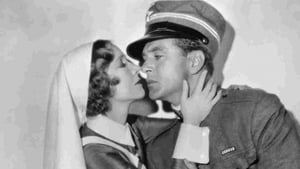Contact: info@alwanfilm.com
Video Sources 0 Views
- Watch trailer
- A Farewell to Arms 1932 Colorized


Synopsis
Table of Contents
ToggleA Farewell to Arms 1932 Colorized Review: Romance and Tragedy in an Early Classic Film

Introduction
Released in 1932, A Farewell to Arms is a powerful adaptation of Ernest Hemingway’s 1929 novel of the same name, capturing the essence of love, loss, and war during World War I. Directed by Frank Borzage, the film explores the tumultuous romance between an American ambulance driver and a British nurse, set against the backdrop of the Great War. It is a poignant drama that intertwines personal and historical tragedy, highlighting the impact of war on individuals. This review will dive deep into the 1932 film’s story, performances, themes, and its colorized version, a later adaptation that offers modern viewers a visually reimagined experience.
In this article, we will explore the enduring legacy of A Farewell to Arms (1932), the significance of its colorized format, and the impact it has had on the history of cinema.
Check The Full Colorized Movies List
Check Our Colorized Movies Trailer Channel
Understanding A Farewell to Arms 1932 Colorized: Director, Cast, and Genre
Director’s Vision
Frank Borzage, a director celebrated for his work in romance and drama, brought A Farewell to Arms to life with a unique focus on the emotional intensity of the story. Borzage was known for his ability to capture the depth of human emotions, particularly love and sacrifice, which makes him an ideal fit for this adaptation. His direction of A Farewell to Arms (1932) steers away from Hemingway’s more cynical tone, instead opting for a more melodramatic take on the material. Borzage’s vision emphasizes the strength of the human spirit, even in the face of overwhelming tragedy.
Borzage’s work is imbued with romanticism, and he uses the romance between the two leads as a counterpoint to the violence and chaos of war. His choice to focus on the personal, rather than the grand political or military aspects of World War I, allows for a more intimate and emotionally resonant film.
The Iconic Performance of Actors
Gary Cooper, one of Hollywood’s most beloved leading men, takes on the role of Lt. Frederic Henry, the American ambulance driver who falls in love with the nurse Catherine Barkley. Cooper’s portrayal of Frederic is both stoic and vulnerable, capturing the emotional depth of a man torn between his duty as a soldier and his desire to escape the horrors of war with the woman he loves. His performance in A Farewell to Arms solidified his place as a cinematic icon, showcasing his ability to convey complex emotions with subtlety and nuance.
Helen Hayes, who plays Catherine Barkley, delivers a tender and moving performance as the British nurse who falls deeply in love with Frederic. Hayes, often referred to as the “First Lady of the American Theatre,” brings a depth of feeling to Catherine that makes her more than just a love interest; she is a woman whose personal sacrifices and desires are deeply felt throughout the film. The chemistry between Cooper and Hayes is palpable, adding emotional weight to their scenes together and making their romance all the more heartbreaking.
Exploring the Genre
A Farewell to Arms (1932) is a quintessential romantic drama, a genre that was popular during the early days of sound cinema. The film blends elements of war, romance, and tragedy to create a moving narrative about love and loss. While it is set against the backdrop of World War I, the film’s focus is largely on the personal rather than the political. It is this blend of sweeping romance and the brutal realities of war that gives the film its emotional power.
Though the film incorporates many of the conventions of a war movie—combat scenes, the camaraderie of soldiers, and the destruction wrought by battle—its primary concern is with the relationship between Frederic and Catherine, and the toll that the war takes on them as individuals. This emphasis on personal drama, rather than war as an event, sets A Farewell to Arms apart from other war films of the era.
Exploring the World of A Farewell to Arms 1932 Colorized: Plot and Characters
Detailed Synopsis
The film follows the journey of Lt. Frederic Henry, an American serving in the Italian army as an ambulance driver during World War I. Frederic meets and falls in love with Catherine Barkley, a British nurse stationed at the front. The two are immediately drawn to one another, and their love affair blossoms amid the chaos and devastation of war.
As their relationship deepens, they are faced with numerous challenges. Frederic is injured during battle and is sent to a hospital where Catherine is assigned to care for him. Their love continues to grow, but the war continues to pull them apart. Catherine becomes pregnant, and the couple makes plans to escape the war and live a quiet life together. However, the brutality of war intervenes, and tragedy strikes before their dreams can be realized.
The film’s final act is both heartbreaking and powerful, as Frederic races against time to reunite with Catherine, only to be confronted with the devastating consequences of their ill-fated romance. The ending, marked by loss and grief, underscores the film’s central theme: the inescapable toll of war on the human soul.
Complex Protagonists and Supporting Characters
Frederic Henry, portrayed by Gary Cooper, is a complex character torn between duty and love. His journey throughout the film is one of emotional growth, as he moves from a man focused on self-preservation to someone who is willing to risk everything for love. Cooper’s understated performance brings a quiet dignity to the role, allowing the audience to feel the weight of Frederic’s internal struggle.
Catherine Barkley, played by Helen Hayes, is a character of great emotional depth. Her love for Frederic is both her salvation and her undoing, as she navigates the dangers of war and the societal expectations placed upon her. Hayes’ performance captures Catherine’s vulnerability and strength, making her a tragic yet heroic figure in her own right.
The supporting characters, including Frederic’s friend Rinaldi (played by Adolphe Menjou), add depth and complexity to the story. Rinaldi’s cynical outlook on love and war serves as a counterpoint to Frederic’s emotional journey, highlighting the different ways individuals cope with the horrors of war.
The Art of Film Colorization
Understanding the Process
Film colorization involves adding color to originally black-and-white films, transforming them into a visually richer experience for modern audiences. This process has been refined over the years, beginning with hand-painted frames and evolving into digital techniques that allow for greater precision and detail. For A Farewell to Arms (1932), the colorization process was undertaken to reintroduce the classic to a new generation of viewers who may not be accustomed to black-and-white films.
In the case of A Farewell to Arms, colorization enhances certain aspects of the film, particularly the dramatic wartime landscapes and the intimate moments between Frederic and Catherine. The muted tones of the battle scenes and the soft, romantic colors of their love scenes provide a contrast that heightens the emotional stakes of the film.
Development Over Time
The colorization of films has evolved significantly since the early days of cinema. What began as a manual, labor-intensive process has become more streamlined and accurate with the advent of digital technology. The colorized version of A Farewell to Arms (1932) represents a modern application of this technology, offering a visually engaging way to experience a classic story.
However, as with all colorized films, the question remains whether color adds to or detracts from the original artistic vision. In the case of A Farewell to Arms, the colorization enhances the visual appeal, bringing new life to the film without overshadowing its emotional core.
Early Colored Films: A Brief History
Emergence of Early Colored Techniques
The history of colored films dates back to the early 20th century, with techniques such as hand-tinting, where individual frames were colored by hand, and two-color Technicolor processes that added limited hues to black-and-white films. These early methods paved the way for more sophisticated color processes like the three-color Technicolor system, which became popular in the 1930s.
While A Farewell to Arms was originally filmed in black-and-white, the desire to experiment with color was already taking hold in Hollywood. By the time the film was colorized decades later, color technology had advanced to the point where it could convincingly recreate the visual nuances of the original film while adding a new dimension to the viewing experience.
A Farewell to Arms and Its Early Colored Version
The Decision to Release in Color
The decision to release a colorized version of A Farewell to Arms (1932) was part of a broader effort to preserve and reintroduce classic films to contemporary audiences. By adding color, the filmmakers aimed to enhance the visual storytelling and make the film more accessible to viewers who might be put off by black-and-white films.
The colorized version allows modern audiences to appreciate the film’s artistry in a new way, highlighting the contrast between the beauty of the romance and the bleakness of war. The decision to colorize A Farewell to Arms was also a nod to the technological advancements in filmmaking, showing how old classics can be revitalized through modern techniques.
Impact on the Visual Narrative
The colorization of A Farewell to Arms (1932) enhances the visual narrative in several key ways. The color palette used for the war scenes is appropriately somber, with muted grays and browns reflecting the grim reality of life on the battlefield. In contrast, the scenes between Frederic and Catherine are bathed in warmer, softer hues, emphasizing the emotional intimacy of their relationship.
By adding color, the film gains an additional layer of visual meaning, helping to underscore the contrast between love and war. However, for purists, the original black-and-white version still holds a certain emotional and historical authenticity that is hard to replicate with colorization.
The Debate Over Film Colorization
Discussing the Controversy
The colorization of black-and-white films has long been a topic of debate among film historians, critics, and purists. On one hand, colorization can breathe new life into older films, making them more appealing to modern audiences. On the other hand, there are concerns that colorization alters the original artistic vision of the filmmakers, potentially undermining the integrity of the work.
In the case of A Farewell to Arms, some critics argue that the black-and-white cinematography is integral to the film’s emotional tone, particularly in its portrayal of the stark realities of war. Others believe that the addition of color enhances the film’s visual storytelling, creating a richer and more immersive experience.
The debate over film colorization ultimately comes down to a question of artistic intent versus technological innovation. While colorization can offer new perspectives on classic films, it is important to consider how these changes affect the original vision of the filmmakers.
Examining A Farewell to Arms as an Early Colored Film
How Colorization Enhances or Detracts from the Experience
For modern audiences, the colorized version of A Farewell to Arms (1932) offers a more visually dynamic experience, with color enhancing the emotional and visual contrasts within the film. The romantic scenes between Frederic and Catherine take on a dreamlike quality with the addition of soft, warm hues, while the war scenes feel more immediate and visceral with the use of darker, more somber tones.
However, for those who appreciate the stark beauty of black-and-white cinematography, the colorization may feel unnecessary or even distracting. The original black-and-white version of the film carries a certain timeless quality, with its use of light and shadow creating a dramatic atmosphere that colorization cannot fully replicate.
Ultimately, whether the colorization of A Farewell to Arms enhances or detracts from the viewing experience depends on individual preferences. Some viewers may appreciate the added visual dimension, while others may prefer the simplicity and emotional clarity of the original black-and-white film.
Influence and Legacy: A Farewell to Arms 1932 Colorized’ Impact on Cinema
Influence on Romantic War Films
A Farewell to Arms (1932) has had a lasting impact on the genre of romantic war films, influencing countless filmmakers who sought to capture the intersection of love and war on screen. Its blend of sweeping romance and the harsh realities of war set a precedent for future films, such as Gone with the Wind (1939) and Casablanca (1942), both of which explored similar themes of love, sacrifice, and the toll of war.
The film also contributed to the development of the war genre itself, showing that war stories could be told not just through grand battle sequences but also through the personal experiences of those caught in the conflict. This focus on the emotional and psychological impact of war has continued to resonate in later films, from The English Patient (1996) to Atonement (2007).
Director’s Cinematic Legacy: Beyond A Farewell to Arms 1932 Colorized
Frank Borzage’s Influence on Cinema
Frank Borzage’s directorial style, characterized by his romanticism and his focus on the emotional lives of his characters, left a lasting legacy in Hollywood. He was one of the first filmmakers to use cinematic techniques to convey the inner lives of his characters, often emphasizing close-ups and lighting to highlight their emotional states. His work on A Farewell to Arms exemplifies this approach, as he uses the camera to draw the audience into the personal struggles of Frederic and Catherine.
Borzage’s influence can be seen in the work of later filmmakers who similarly emphasize the emotional and psychological dimensions of their characters. His focus on the intimate moments between characters, often set against larger historical or social backdrops, has become a hallmark of romantic dramas and continues to inspire filmmakers today.
Themes Explored in A Farewell to Arms 1932 Colorized
Darkness, War, and Love
At its core, A Farewell to Arms is a story about the ways in which war destroys not only lives but also love and hope. The film explores themes of darkness and despair, as Frederic and Catherine’s love is constantly threatened by the violence and chaos of the world around them. Despite their best efforts to escape the war and find happiness, they are ultimately unable to outrun the devastation that surrounds them.
The film also touches on themes of honor and sacrifice, as Frederic grapples with his duty as a soldier and his desire to protect the woman he loves. These themes are explored not only through the central romance but also through the supporting characters, particularly Rinaldi, whose cynicism about love and war serves as a foil to Frederic’s idealism.
Reception and Controversy Surrounding A Farewell to Arms 1932 Colorized
Critical Reception and Audience Reactions
Upon its release in 1932, A Farewell to Arms was met with critical acclaim, particularly for its performances and its emotional depth. Gary Cooper and Helen Hayes were praised for their portrayals of Frederic and Catherine, with many critics noting their chemistry and the intensity of their performances. The film’s direction and cinematography were also lauded, with Borzage’s use of lighting and close-ups to convey emotion standing out as a highlight.
However, the film’s colorized version, released decades later, sparked controversy among purists who felt that the addition of color compromised the original artistic vision. While some appreciated the visual enhancements that color brought to the film, others argued that the black-and-white cinematography was integral to the film’s emotional tone and that colorization detracted from the film’s historical authenticity.
Where to Watch A Farewell to Arms 1932 ColorizedOnline
For those interested in experiencing A Farewell to Arms (1932), the film is available on several streaming platforms. Services like Amazon Prime Video and the Criterion Channel offer the original black-and-white version, as well as the colorized edition. Additionally, DVD and Blu-ray versions of the film, including both formats, are available for purchase.
FAQs About A Farewell to Arms 1932 Colorized
Q: How closely does the film follow Hemingway’s novel?
A: While the film remains faithful to the general plot of Hemingway’s novel, it takes liberties with the tone and certain details, particularly in its portrayal of the romance between Frederic and Catherine. Borzage’s direction emphasizes melodrama and romanticism, whereas Hemingway’s novel is more restrained and cynical in its depiction of love and war.
Q: Is the colorized version of A Farewell to Arms worth watching?
A: The colorized version offers a visually enhanced experience, but whether it is worth watching depends on personal preferences. Some viewers may appreciate the added dimension that color brings to the film, while others may prefer the emotional clarity and historical authenticity of the original black-and-white version.
Q: What awards did A Farewell to Arms (1932) receive?
A: The film was nominated for four Academy Awards, including Best Picture, Best Cinematography, and Best Art Direction. It won two Oscars for Best Cinematography and Best Sound.
Conclusion
A Farewell to Arms (1932) remains a timeless classic, capturing the emotional devastation of war and the fragility of love. Frank Borzage’s direction, combined with powerful performances by Gary Cooper and Helen Hayes, creates a film that resonates with audiences even today. The debate over the colorization of the film underscores the tension between preserving the original artistic vision and making classic films accessible to modern viewers.
Whether in its original black-and-white format or its colorized version, A Farewell to Arms (1932) continues to captivate audiences with its poignant story and emotional depth. As a testament to the enduring power of cinema, it invites viewers to reflect on the complexities of love, war, and the human condition.














